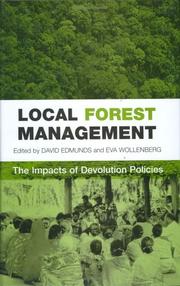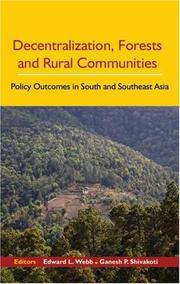| Listing 1 - 10 of 37 | << page >> |
Sort by
|

ISBN: 1417522216 9786610476077 6000000146 1136562117 1280476079 1849771855 9781849771856 9781280476075 1844070220 9781844070220 1844070239 9781844070237 9781136562068 9781136562105 9781136562112 1136562109 Year: 2003 Publisher: London ; Sterling, VA : Earthscan Publications Ltd.,
Abstract | Keywords | Export | Availability | Bookmark
 Loading...
Loading...Choose an application
- Reference Manager
- EndNote
- RefWorks (Direct export to RefWorks)
'A well written book, astutely organized.'Development and ChangeLocal Forest Management is built around careful and illuminating case studies of the effects of devolution policies on the management of forests in several Asian countries. The studies demonstrate that devolution policies - contrary to the claims of governments - actually increased governmental control over the management of local resources and did so at lower cost. The controversial findings show that if local forest users are to exercise genuine control over forest management, they must be better represented in the processes of
Forest policy --- Forest management --- Forest resource policy --- Forests and forestry --- State and forestry --- Economic policy --- Government policy
Book
ISBN: 9780821418642 0821418645 9780821418659 0821418653 9780821443965 0821443968 Year: 2009 Publisher: Athens, Ohio : Ohio University Press,
Abstract | Keywords | Export | Availability | Bookmark
 Loading...
Loading...Choose an application
- Reference Manager
- EndNote
- RefWorks (Direct export to RefWorks)
Forests have been at the fault lines of contact between African peasant communities in the Tanzanian coastal hinterland and outsiders for almost two centuries. In recent decades, a global call for biodiversity preservation has been the main challenge to Tanzanians and their forests. Thaddeus Sunseri uses the lens of forest history to explore some of the most profound transformations in Tanzania from the nineteenth century to the present. He explores anticolonial rebellions, the world wars, the depression, the Cold War, oil shocks, and nationalism through their intersections with and impacts
Forest policy --- Forests and forestry --- History --- Social aspects --- Forest management --- Forest resource policy --- State and forestry --- Economic policy --- Forest land --- Forest lands --- Forest planting --- Forest production --- Forest sciences --- Forestation --- Forested lands --- Forestland --- Forestlands --- Forestry --- Forestry industry --- Forestry sciences --- Land, Forest --- Lands, Forest --- Silviculture --- Sylviculture --- Woodlands --- Woods (Forests) --- Agriculture --- Natural resources --- Afforestation --- Arboriculture --- Logging --- Timber --- Tree crops --- Trees --- Political aspects --- History. --- Government policy

ISBN: 128196526X 9786611965266 8178299593 9788178299594 9781281965264 0761935487 9780761935483 9352801725 Year: 2008 Publisher: Los Angeles : Sage Publications,
Abstract | Keywords | Export | Availability | Bookmark
 Loading...
Loading...Choose an application
- Reference Manager
- EndNote
- RefWorks (Direct export to RefWorks)
Asian societies are entering a new era of decentralized governance of forests. The authority to make decisions on forest management has shifted to lower levels. of government and, in some cases, to the local people themselves. But can governments. simply `decentralize` authority away from the center, or are there certain core. elements necessary to achieve sustainable management and conservation of forests. in a decentralized world?. This book argues that policy solutions to resource dilemmas faced by forest-accessing. rural communities must be flexible, and should allow for local dynamics and
Forest policy --- Forest management --- Decentralization in management --- Centralization in management --- Delegation of authority --- Management --- Forest administration --- Forest plants --- Forest resource administration --- Forest resource management --- Forest stewardship --- Forest vegetation management --- Forestry management --- Forests and forestry --- Stewardship, Forest --- Vegetation management, Forest --- Ecosystem management --- Natural resources --- Forest resource policy --- State and forestry --- Economic policy --- Administration --- Control --- Government policy

ISBN: 1589012801 1435627504 9781435627505 9781589011236 1589011236 9781589012806 1589011236 Year: 2006 Publisher: Washington, D.C. : Georgetown University Press,
Abstract | Keywords | Export | Availability | Bookmark
 Loading...
Loading...Choose an application
- Reference Manager
- EndNote
- RefWorks (Direct export to RefWorks)
Sarah B. Pralle takes an in-depth look at why some environmental conflicts expand to attract a lot of attention and participation, while others generate little interest or action. Branching Out, Digging In examines the expansion and containment of political conflict around forest policies in the United States and Canada. Late in 1993 citizens from around the world mobilized on behalf of saving old-growth forests in Clayoquot Sound. Yet, at the same time only a very few took note of an even larger reserve of public land at risk in northern California.
Environmental policy --- Forest management --- Forest policy --- Environment and state --- Environmental control --- Environmental management --- Environmental protection --- Environmental quality --- State and environment --- Environmental auditing --- Forest administration --- Forest plants --- Forest resource administration --- Forest resource management --- Forest stewardship --- Forest vegetation management --- Forestry management --- Forests and forestry --- Stewardship, Forest --- Vegetation management, Forest --- Ecosystem management --- Natural resources --- Forest resource policy --- State and forestry --- Economic policy --- Government policy --- Management --- Administration --- Control

ISBN: 1597266329 1429495057 9781429495059 1597260878 9781597260879 9781597266321 Year: 2006 Publisher: Washington : Island Press,
Abstract | Keywords | Export | Availability | Bookmark
 Loading...
Loading...Choose an application
- Reference Manager
- EndNote
- RefWorks (Direct export to RefWorks)
Wildfires --- Forest fires --- Fire ecology --- Forest policy --- Forest management --- Forest resource policy --- Forests and forestry --- State and forestry --- Economic policy --- Ecopyrology --- Fires --- Fire --- Ecology --- Natural disasters --- Deforestation --- Fire weather --- Bush fires --- Bushfires --- Wild fires --- Wildland fires --- History. --- Government policy --- Environmental aspects
Book
ISBN: 9251075875 9789251075876 9789251075869 9251075867 Year: 2013 Volume: no. 2 Publisher: Rome : Food and Agriculture Organization of the United Nations,
Abstract | Keywords | Export | Availability | Bookmark
 Loading...
Loading...Choose an application
- Reference Manager
- EndNote
- RefWorks (Direct export to RefWorks)
Forest policy. --- Forest management. --- Forest administration --- Forest plants --- Forest resource administration --- Forest resource management --- Forest stewardship --- Forest vegetation management --- Forestry management --- Forests and forestry --- Stewardship, Forest --- Vegetation management, Forest --- Ecosystem management --- Natural resources --- Forest management --- Forest resource policy --- State and forestry --- Economic policy --- Management --- Administration --- Control --- Government policy
Book
ISBN: 9351502600 9789351502609 9789351505310 9351505316 9789351502593 9351502597 Year: 2015 Publisher: New Delhi, India : SAGE,
Abstract | Keywords | Export | Availability | Bookmark
 Loading...
Loading...Choose an application
- Reference Manager
- EndNote
- RefWorks (Direct export to RefWorks)
A fresh look and comparative perspectives from various Asian countries on multi-level forest governance This book presents the remarkable diversity of policy implementation in forest resource management in 14 Asian countries: five in South Asia (Bangladesh, India, Nepal, Sri Lanka and Bhutan), six in South-east Asia (Indonesia, Malaysia, the Philippines, Thailand, Vietnam and Laos) and three in East Asia (China, Korea and Japan). It explores how effective forest governance can be achieved by bridging multi-level outcomes. Further, this volume highlights the importance of context in defining f
Forest policy --- Forest management --- Decentralization in management --- Centralization in management --- Delegation of authority --- Management --- Forest administration --- Forest plants --- Forest resource administration --- Forest resource management --- Forest stewardship --- Forest vegetation management --- Forestry management --- Forests and forestry --- Stewardship, Forest --- Vegetation management, Forest --- Ecosystem management --- Natural resources --- Forest resource policy --- State and forestry --- Economic policy --- Administration --- Control --- Government policy --- E-books
Book
ISBN: 8776944018 9788776944018 9788776941666 8776941663 8776941671 9788776941673 Year: 2016 Publisher: Copenhagen
Abstract | Keywords | Export | Availability | Bookmark
 Loading...
Loading...Choose an application
- Reference Manager
- EndNote
- RefWorks (Direct export to RefWorks)
Forest policy --- Forest management --- Forest administration --- Forest plants --- Forest resource administration --- Forest resource management --- Forest stewardship --- Forest vegetation management --- Forestry management --- Forests and forestry --- Stewardship, Forest --- Vegetation management, Forest --- Ecosystem management --- Natural resources --- Forest resource policy --- State and forestry --- Economic policy --- Management --- Administration --- Control --- Government policy
Periodical
ISSN: 18727050 13899341 Year: 2000 Publisher: [Amsterdam] ; [New York] : Elsevier Science,
Abstract | Keywords | Export | Availability | Bookmark
 Loading...
Loading...Choose an application
- Reference Manager
- EndNote
- RefWorks (Direct export to RefWorks)
Forest policy --- Forests and forestry --- Economic aspects --- Politique forestière --- Forêts --- Aspect économique --- Forest land --- Forest lands --- Forest planting --- Forest production --- Forest sciences --- Forestation --- Forested lands --- Forestland --- Forestlands --- Forestry --- Forestry industry --- Forestry sciences --- Land, Forest --- Lands, Forest --- Silviculture --- Sylviculture --- Woodlands --- Woods (Forests) --- Forest management --- Forest resource policy --- State and forestry --- Government policy --- Agriculture --- Natural resources --- Afforestation --- Arboriculture --- Logging --- Timber --- Tree crops --- Trees --- Economic policy --- Forest policy. --- Economic aspects. --- Forest economics --- Forestry economics

ISBN: 0387225803 9786610461820 1280461829 0387226915 Year: 2004 Publisher: New York : Springer Science,
Abstract | Keywords | Export | Availability | Bookmark
 Loading...
Loading...Choose an application
- Reference Manager
- EndNote
- RefWorks (Direct export to RefWorks)
Martens and Fishers (Martes) in Human-Altered Environments: An International Perspective examines the conditions where humans and martens are compatible and incompatible, and promotes land use practices that allow Martes to be representatively distributed and viable. All Martes have been documented to use forested habitats and 6 species (excluding the stone marten) are generally considered to require complex mid- to late-successional forests throughout much of their geographic ranges. All species in the genus require complex horizontal and vertical structure to provide escape cover protection from predators, habitat for their prey, access to food resources, and protection from the elements. Martens and the fisher have high metabolic rates, have large spatial requirements, have high surface area to volume ratios for animals that often inhabit high latitudes, and often require among the largest home range areas per unit body weight of any group of mammals. Resulting from these unique life history characteristics, this genus is particularly sensitive to human influences on their habitats, including habitat loss, stand-scale simplification of forest structure via some forms of logging, and landscape-scale effects of habitat fragmentation. Given their strong associations with structural complexity in forests, martens and the fisher are often considered as useful barometers of forest health and have been used as ecological indicators, flagship, and umbrella species in different parts of the world. Thus, efforts to successfully conserve and manage martens and fishers are associated with the ecological fates of other forest dependent species and can greatly influence ecosystem integrity within forests that are increasingly shared among wildlife and humans. We have made great strides in our fundamental understanding of how animals with these unique life history traits perceive and utilize habitats, respond to habitat change, and how their populations function and perform under different forms of human management and mismanagement. This knowledge enhances our basic understanding of all species of Martes and will help us to achieve the goal of conserving viable populations and representative distributions of the world’s Martes, their habitats, and associated ecological communities in our new millennium.
Martens. --- Fisher (Mammal) --- Martens --- Forest ecology. --- Forest policy. --- Nature --- Habitat. --- Effect of human beings on. --- Forest resource policy --- State and forestry --- Fisher --- Fisher (Animal) --- Fishers (Mammals) --- Martes pennanti --- Pekan --- Pennant's marten --- Life sciences. --- Animal ecology. --- Life Sciences. --- Animal Ecology. --- Anthropogenic effects on nature --- Ecological footprint --- Human beings --- Anthropogenic soils --- Human ecology --- Forest management --- Forests and forestry --- Economic policy --- Martes --- Ecology --- Government policy --- Animals --- Zoology
| Listing 1 - 10 of 37 | << page >> |
Sort by
|

 Search
Search Feedback
Feedback About UniCat
About UniCat  Help
Help News
News